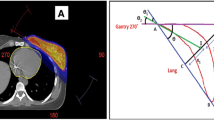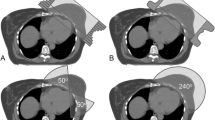Abstract
Purpose
To find an optimal arc design for hybrid volumetric modulated arc therapy (H-VMAT), a combination of conventional 3DCRT and VMAT plans for left-sided whole breast radiation therapy.
Methods and materials
A total of 26 left-sided early-stage breast cancer patients were selected for this study. To find the superior plan, H-VMAT with three different arc designs including, two partial arcs (2A), four partial arcs (4A) and four tangential arcs (TA) were created for each study case by combining 3DCRT and VMAT with 75% 3DCRT/25% VMAT dose proportion of prescription dose.
Results
All H-VMAT plans achieved the expected target coverage. A higher conformity index and homogeneity index were achieved for 2A and 4A H-VMAT plans and significantly differ from TA H-VMAT (p < 0.003). The heart and ipsilateral lung dose parameters were comparable among all plans except heart V40Gy which was significantly less in 4A H-VMAT plan (p < 0.05). The contralateral lung, contralateral breast, spinal cord, normal tissue doses and MU were significantly less in TA H-VMAT (p < 0.03). The beam-on time was significantly less in 2A H-VMAT (p < 0.0001).
Conclusion
2A and 4A H-VMAT techniques are effective in improving the PTV dosimetric parameters as well as reducing the OAR doses. Further, 2A H-VMAT delivers less MU and beam-on time compared to 4A H-VMAT.



Similar content being viewed by others
References
Bray F, Ren JS, Masuyer E et al (2013) Global estimates of cancer prevalence for 27 sites in the adult population in 2008. Int J Cancer 132(5):1133–1145. https://doi.org/10.1002/ijc.27711
Early Breast Cancer Trialists’ Collaborative Group (EBCTCG) (2005) Effect of radiotherapy after breast-conserving surgery on 10-year recurrence and 15-year breast cancer death: meta-analysis of individual patient data for 10801 women in 17 randomized trials. Lancet 365:1687–1717
Byers T, Wender RC, Jemal A et al (2016) The American Cancer Society challenge goal to reduce US cancer mortality by 50% between 1990 and 2015: results and reflections. CA Cancer J Clin 66:359–369
Balaji K, Subramanian B, Yadav P et al (2016) Radiation therapy for breast cancer: literature review. Med Dosim 41(3):253–257. https://doi.org/10.1016/j.meddos.2016.06.005
Darby SC, Ewertz M, McGale P et al (2013) Risk of ischemic heart disease in women after radiotherapy for breast cancer. N Engl J Med 368(11):987–998. https://doi.org/10.1056/NEJMoa1209825
Gagliardi G, Constine LS, Moiseenko V et al (2010) Radiation dose–volume effects in the heart. Int J Radiat Oncol Biol Phys 76(3):S77–S85. https://doi.org/10.1016/j.ijrobp.2009.04.093
Chung E, Corbett JR, Moran JM et al (2013) Is there a dose-response relationship for heart disease with low-dose radiation therapy? Int J Radiat Oncol Biol Phys 85(4):959–964
Ishikura S, Nihei K, Ohtsu A et al (2003) Long-term toxicity after definitive chemoradiotherapy for squamous cell carcinoma of the thoracic esophagus. J Clin Oncol 21(14):2697–2702
Taylor CW, McGale P, Darby SC (2006) Cardiac risks of breast-cancer radiotherapy: a contemporary view. Clin Oncol 18:236–246. https://doi.org/10.1016/j.clon.2005.11.003
Marks LB, Bentzen SM, Deasy JO et al (2010) Radiation dose–volume effects in the lung. Int J Radiat Oncol Biol Phys 76(3):S70–S76. https://doi.org/10.1016/j.ijrobp.2009.06.091
Chung Y, Yoon HI, Kim YB et al (2012) Radiation pneumonitis in breast cancer patients who received radiotherapy using the partially wide tangent technique after breast conserving surgery. J Breast Cancer 15(3):337–343. https://doi.org/10.4048/jbc.2012.15.3.337
Blom GU, Wennberg B, Svane G et al (2010) Reduction of radiation pneumonitis by V20-constraints in breast cancer. Radiat Oncol 5:99. https://doi.org/10.1186/1748-717X-5-99
Hall EJ (2006) Intensity-modulated radiation therapy, protons, and the risk of second cancers. Int J Radiat Oncol Biol Phys 65(1):1–7. https://doi.org/10.1016/j.ijrobp.2006.01.027
Stovall M, Smith SA, Langholz BM et al (2008) Dose to the contralateral breast from radiotherapy and risk of second primary breast cancer in the WECARE study. Int J Radiat Oncol Biol Phys 72:1021–1030. https://doi.org/10.1016/j.ijrobp.2008.02.040
Tortorelli G, Di Murro I, Barbarino R et al (2013) Standard or hypofractionated radiotherapy in the postoperative treatment of breast cancer: s retrospective analysis of acute skin toxicity and dose inhomogeneities. BMC Cancer 13:230
Pignol JP, Olivotto I, Rakovich E et al (2008) A multicenter randomized trial of breast intensity-modulated radiation therapy to reduce acute radiation dermatitis. J Clin Oncol 26(13):2085–2092
Mayo CS, Urie MM, Fitzgerald TJ (2005) Hybrid IMRT plans-concurrently treating conventional and IMRT beams for improved breast irradiation and reduced planning time. Int J Radiat Oncol Biol Phys 61:922–932. https://doi.org/10.1016/j.ijrobp.2004.10.033
Farace P, Zucca S, Solla I et al (2012) Planning hybrid intensity modulated radiation therapy for whole-breast irradiation. Int J Radiat Oncol Biol Phys 84(1):e115–e122. https://doi.org/10.1016/j.ijrobp.2012.02.025
Shiau A, Hsieh C, Tien H et al (2014) Left-sided whole breast irradiation with hybrid-IMRT and helical tomotherapy dosimetric comparison. BioMed Res Int. https://doi.org/10.1155/2014/741326
Jeulink M, Dahele M, Meijnen P et al (2015) Is there a preferred IMRT technique for left-breast irradiation? J Appl Clin Med Phys 16:197–205. https://doi.org/10.1120/jacmp.v16i3.5266
Chen YG, Li AC, Li WY et al (2017) The feasibility study of a hybrid coplanar arc technique versus hybrid intensity-modulated radiotherapy in treatment of early-stage left-sided breast cancer with simultaneous-integrated boost. J Med Phys 42(1):1–8. https://doi.org/10.4103/jmp.JMP_56_17
Lin J, Yeh D, Yeh H et al (2015) Dosimetric comparison of hybrid volumetric-modulated arc therapy, volumetric-modulated arc therapy and intensity-modulated radiation therapy for left-sided early breast cancer. Med Dosim 40(3):262–267. https://doi.org/10.1016/j.meddos.2015.05.003
BalajiSubramanian S, Balaji K, Thirunavukarasu M et al (2016) Bilateral breast irradiation using hybrid volumetric modulated arc therapy (h-VMAT) technique: a planning case report. Cureus 8(12):e914. https://doi.org/10.7759/cureus.91424
Balaji K, Yadav P, BalajiSubramanian S et al (2018) Hybrid volumetric modulated arc therapy for chest wall irradiation: for a good plan, get the right mixture. Phys Med 52:86–92. https://doi.org/10.1016/j.ejmp.2018.06.641
BalajiSubramanian S, Balaji K, Thirunavukarasu M et al (2017) Sparing dysphagia/aspiration related structures using novel hybrid volumetric modulated arc therapy. Phys Med 39:80–87. https://doi.org/10.1016/j.ejmp.2017.05.073
Mayo CS, Urie MM, Fitzgerald TJ (2008) Hybrid IMRT for treatment of cancers of the lung and esophagus. Int J Radiat Oncol Biol Phys 71:1408–1418. https://doi.org/10.1016/j.ijrobp.2007.12.008
Amaloo C, Nazareth DP, Kumaraswamy LK (2015) Comparison of hybrid volumetric modulated arc therapy (VMAT) technique and double arc VMAT technique in the treatment of prostate cancer. Radiol Oncol 49(3):291–298. https://doi.org/10.1515/raon.2015.0018
Viren T, Heikkilä J, Myllyoja K et al (2015) Tangential volumetric modulated arc therapy technique for left-sided breast cancer radiotherapy. Radiat Oncol 10:79
Tsai PF, Lin SM, Lee SH et al (2012) The feasibility study of using multiple partial volumetric-modulated arcs therapy in early stage left-sided breast cancer patients. J Appl Clin Med Phys 13:62–73. https://doi.org/10.1120/jacmp.v13i5.3806
Fogliata A, Seppala J, Reggiori G et al (2017) Dosimetric trade-offs in breast treatment with VMAT technique. Br J Radiol 90(1070):20160701. https://doi.org/10.1259/bjr.20160701
International Commission on Radiation Units and Measurements (2010) ICRU report 83: prescribing recording and reporting photon beam intensity modulated radiation therapy (IMRT). ICRU Rep 10(1):1–92
Paddick A (2000) A simple scoring ratio to index the conformity of radiosurgical treatment plans. J Neurosurg 93(3):219–222. https://doi.org/10.3171/jns.2000.93.supplement
Das IJ, Andrews JZ, Cao M et al (2013) Correlation of 2D parameters to lung and heart dose–volume in radiation treatment of breast cancer. Acta Oncol 52:178–183. https://doi.org/10.3109/0284186X.2012.673737
Abo-Madyan Y, Aziz MH, Aly MM et al (2014) Second cancer risk after 3D-CRT, IMRT and VMAT for breast cancer. Radiother Oncol 110:471–476. https://doi.org/10.1016/j.radonc.2013.12.002
Zhou S, Zhu X, Zhang M et al (2016) Estimation of internal organ motion-induced variance in radiation dose in non-gated radiotherapy. Phys Med Biol 61:8157–8179. https://doi.org/10.1088/0031-9155/61/23/8157
Boman E, Roddi M, Haltamo M et al (2016) A new split arc VMAT technique for lymph node positive breast cancer. Phys Med 32:1428–1436. https://doi.org/10.1016/j.ejmp.2016.10.012
Lai Y, Chen Y, Wu S et al (2016) Modified volumetric modulated arc therapy in left sided breast cancer after radical mastectomy with flattening filter free versus flattened beams. Medicine 95(14):e3295. https://doi.org/10.1097/MD.0000000000003295
Kinoshita R, Shimizu S, Taguchi H et al (2008) Three-dimensional intrafractional motion of breast during tangential breast irradiation monitored with high-sampling frequency using a real-time tumor-tracking radiotherapy system. Int J Radiat Oncol Biol Phys 70(3):931–934. https://doi.org/10.1016/j.ijrobp.2007.10.003
Michalski A, Atyeo J, Cox J et al (2012) Inter- and intra-fraction motion during radiation therapy to the whole breast in the supine position: a systematic review. J Med Imaging Radiat Oncol 56(5):499–509. https://doi.org/10.1111/j.1754-9485.2012.02434.x
Author information
Authors and Affiliations
Corresponding author
Ethics declarations
Conflict of interest
All authors who contributed to this study declare that they have no conflict of interest with respect to the manuscript.
Ethical approval
Institutional scientific and ethics board has approved this study. This article does not contain any studies with human participants performed by any of the authors.
Informed consent
The informed consent has been waived off by the ethics board of the institute considering this as a retrospective study with no human involved. For this type of study, formal consent is not required.
Additional information
Publisher's Note
Springer Nature remains neutral with regard to jurisdictional claims in published maps and institutional affiliations.
Rights and permissions
About this article
Cite this article
Ramasubramanian, V., Balaji, K., Balaji Subramanian, S. et al. Hybrid volumetric modulated arc therapy for whole breast irradiation: a dosimetric comparison of different arc designs. Radiol med 124, 546–554 (2019). https://doi.org/10.1007/s11547-019-00994-1
Received:
Accepted:
Published:
Issue Date:
DOI: https://doi.org/10.1007/s11547-019-00994-1




